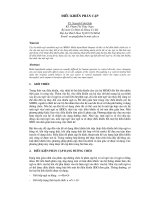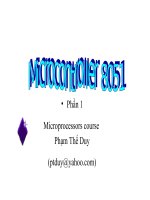Tài liệu Digital Photography - Phần 1 pptx
Bạn đang xem bản rút gọn của tài liệu. Xem và tải ngay bản đầy đủ của tài liệu tại đây (50.61 KB, 5 trang )
Tìm hiểu về Digital Photography
Dưới đây là bài học ngắn về digital photography góp nhặt từ Internet-
Bài này được tác giả là giáo sư nhiếp ảnh Dennis Curtin cho phép đăng lại
để dùng vào mục đích giáo dục. Mỗi kỳ báo sẽ có một chương ngắn về đề tài
digital để chúng ta cùng học thêm. Tuy nhiên chúng ta nên nhớ rằng : Kiến
thức căn bản cần được trau dồi trước đã, và từ những bài học căn bản nhiếp
ảnh của các máy chụp phim và khía cạnh nghệ thuật lãnh hội qua các lớp
học căn bản. Ta sẽ sáng tạo ra nhiều hình ảnh giá trị, dùng bất cứ phương
thức nào cũng được. Xin các bạn chịu khó đọc bài này bằng tiếng Anh
nguyên bản.
Digital photographs are made up of hundreds of thousands or millions
of tiny squares called picture elements-or just pixels. Like the impressionists
who painted wonderful scenes with small dabs of paint, your computer and
printer can use these tiny pixels to display or print photographs. To do so,
the computer divides the screen or printed page into a grid of pixels. It then
uses the values stored in the digital photograph to specify the brightness and
color of each pixel in this grid-a form of painting by number. Controlling, or
addressing a grid of individual pixels in this way is called bit mapping and
digital images are called bit-maps.
Image size
The quality of a digital image, whether printed or displayed on a
screen, depends in part on the number of pixels used to create the image
(sometimes referred to as resolution). More pixels add detail and sharpen
edges.
If you enlarge any digital image enough, the pixels will begin to
show-an effect called pixelization. This is not unlike traditional silver-based
prints where grain begins to show when prints are enlarged past a certain
point. The more pixels there are in an image, the more it can be enlarged
before pixelization occurs.
The size of a photograph is specified in one of two ways-by its
dimensions in pixels or by the total number of pixels it contains. For
example, the same image can be said to have 1800 x 1600 pixels (where "x"
is pronounced "by" as in "1800 by 1600"), or to contain 2.88-million pixels
(1800 multiplied by 1600).
WHY GO DIGITAL?
Once captured, digital photographs are already in a format that makes
them incredibly easy to distribute and use. For example, you can insert
digital photographs into word processing documents, send them by e-mail to
friends, or post them on a Web site where anyone in the world can see them.
With many cameras you can immediately see your images on a small LCD
screen on the back of most cameras, or you can connect the camera to a TV
and show them much like a slide show. Some cameras can even be
connected to a microscope to display dramatically enlarged images on a
large-screen TV. Digital photography is instant photography without the
film costs!
If you're considering going digital, here are a few more reasons to get
even more serious.
- Going digital saves you money in the long run by not buying rolls
and rolls of film and paying for development.
- It saves you time because you don't have to make two trips to the
store to drop off and then pick up your pictures.
- Digital cameras instantly show you how your pictures look so you'll
no longer have those disappointments a day or two later when your film is
developed.
- You can view images before they are printed and if you don't like
what you see, edit them to perfection or delete them.
- Digital photography doesn't use the toxic chemicals that often end up
flowing down the drain and into our streams, rivers, and lakes.
- No more waiting to finish a roll before having it processed. (Or
wasting unexposed film when you can't wait.)
Digital cameras are becoming more than just cameras. Some digital
cameras are capable of capturing not only still photographs, but also sound
and even video-they are becoming more like multimedia recorders than
cameras.
In addition to displaying and distributing photographs, you can also
use a photo-editing program to improve or alter them. For example, you can
crop them, remove red-eye, change colors or contrast, and even add and
delete elements. It's like having a darkroom with the lights on and without
the chemicals.









